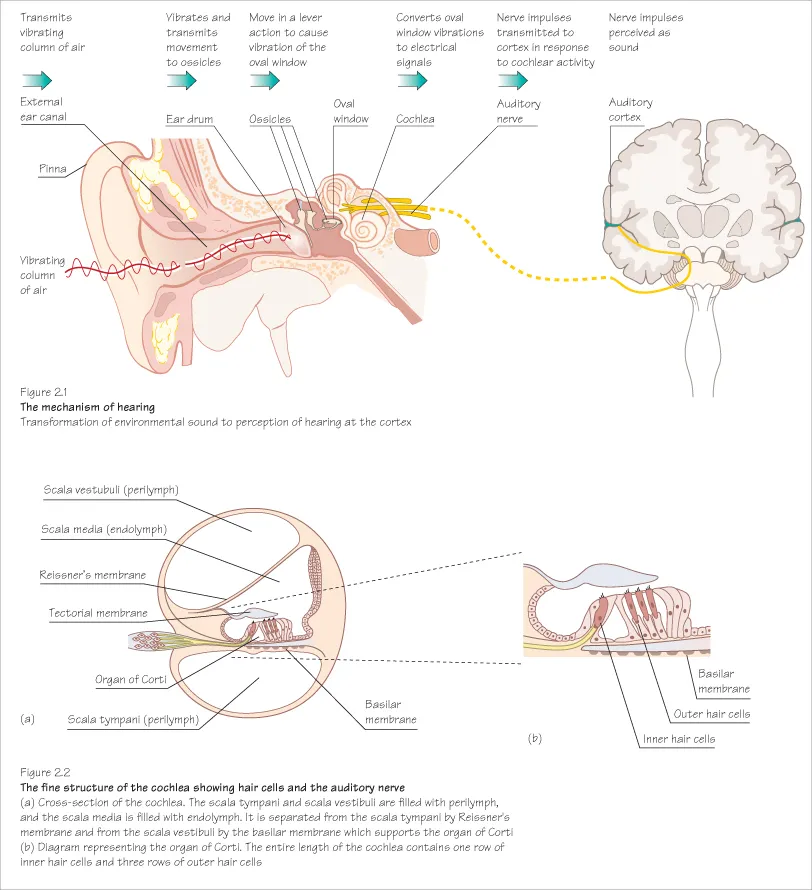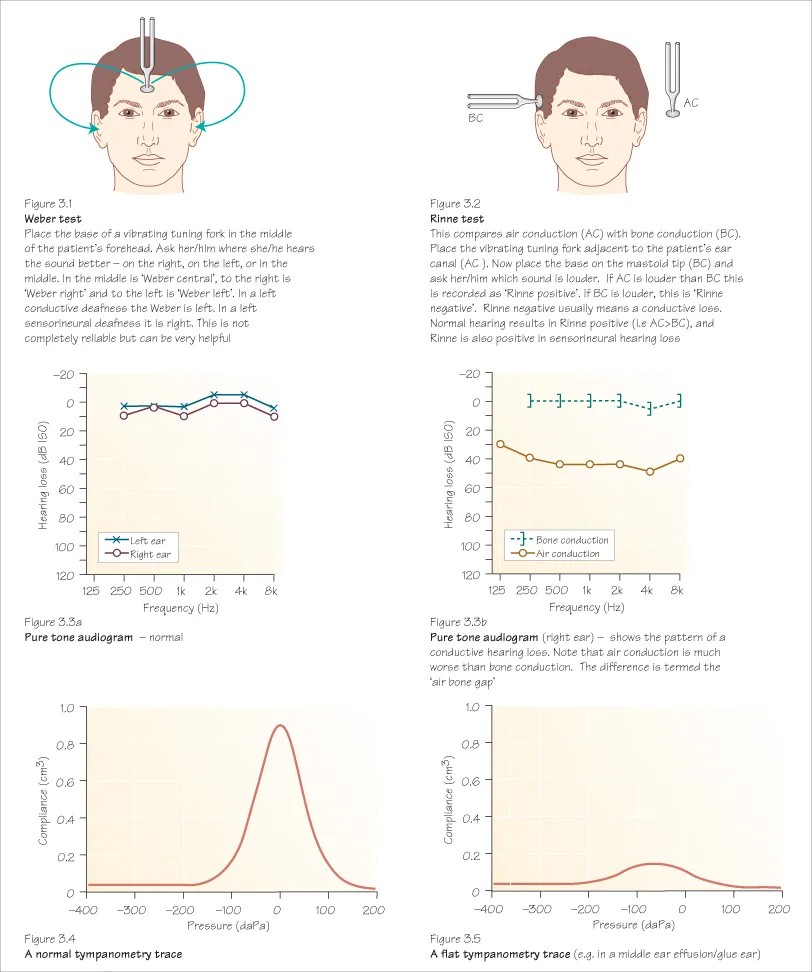
- English
- ePUB (mobile friendly)
- Available on iOS & Android
Ear, Nose and Throat at a Glance
About This Book
Ear, Nose and Throat at a Glance
The market-leading at a Glance series is used world-wide by medical students, residents, junior doctors and health professionals for its concise and clear approach and superb illustrations.
Each topic is presented in a double-page spread with clear, easy-to-follow diagrams, supported by succinct explanatory text.
Covering the whole medical curriculum, these introductory texts are ideal for teaching, learning and exam preparation, and are useful throughout medical school and beyond.
Everything you need to know about Ear, Nose and Throat... at a Glance!
Ear, Nose and Throat at a Glance provides a highly-illustrated, accessible introduction to this practical but complex topic, which is increasingly encountered in every-day outpatient settings, as well as surgical departments.
Each double-page spread diagrammatically summarises the basic science relating to each anatomical area, outlines practical guidelines on the examination of patients, and provides an overview of the most common disorders and diseases.
This brand new title in the best-selling at a Glance series features high-yield information on all the topics covered at medical school, and includes:
- Advice on clinical skills, practical examinations and procedures, such as otoscopic examinations, and tuning fork tests
- Comprehensive illustrations showing anatomy and mechanisms of hearing
- Assessment, management and treatment of both chronic and acute Conditions
- ENT trauma and emergencies
- Multiple Choice Questions (MCQs) and Extended Matching Questions (EMQs) to help test learning
Ear, Nose and Throat at a Glance is the ideal companion for anyone about to start the ENT attachment, or 'special senses' rotation, and will appeal to medical students and junior doctors, as well as nurses, audiologists and other health professionals.
Frequently asked questions
Information

The Ear
External Ear
- The pinna
- The external auditory meatus (ear canal)
- Lateral portion of tympanic membrane (ear drum)
Middle Ear
Inner Ear
- The part of the middle ear behind the pars flaccida is called the ‘attic’.
- The cochlea – this part of the inner ear creates electrical impulses in the cochlear nerve (cranial nerve VIII). These impulses are relayed to the brain to be perceived as sound.
- The vestibule and labyrinth (semicircular canals) – these are involved in balance control.
Anatomical Relations of the Ear
- Eustachian tube (Figures 1.1 and 1.3) This is a part bony and part cartilaginous tube lined with ciliated epithelium that connects the middle ear space with the nasopharynx. Infection in the nose and pharynx can easily track up this tube to the middle ear, which is really a part of the upper respiratory tract. The Eustachian tube is especially important in children – it is wider, shorter and more upright than in adults. Gently hold your nose, close your mouth and try to exhale – you will feel air entering your middle ear via the Eustachian tube.
- Mastoid air cell system The mastoid process is a bony lump behind the pinna that contains a honeycomb network of epithelium-lined air cells (mastoid air cells). The mastoid air cell system opens directly into the middle ear cleft (Figure 1.3). Infection can track in here to cause ‘mastoiditis’ (see Figure 8.3).
- Middle cranial fossa This contains the temporal lobe of the brain and sits just above the middle ear so meningitis and brain abscess are possible complications of ear infection.
- Venous sinuses These surround the brain and carry blood to the neck veins and are also closely related to the middle ear and mastoid. Infection can propagate and result in potentially fatal cavernous sinus thrombosis.
- Facial nerve The seventh cranial nerve runs through the mastoid and the middle ear. It supplies the muscles of facial expression and is at risk in ear infections and in some types of ear surgery.
- Look at the pinna and the mastoid and check for swellings, scars and colour change.
- Use a good quality otoscope (auriscope) to obtain a view of the eardrum. Use the biggest speculum that will comfortably fit and do not put it in too far.
- You may need to straighten the ear canal by pulling the pinna upwards and backwards to help fit the speculum in.
- Note the condition of the skin of the external ear and try to get a good look at the eardrum in a systematic manner.
- Complete examination includes tuning fork tests, hearing assessment, assessment of facial nerve function and post-nasal space examination to look at the Eustachian tube opening.

Physiology of Hearing
Types of Hearing Loss
Conductive Hearing Loss
Sensorineural Hearing Loss

Voice Tests
Tuning Fork Tests
- Use a 512-KHz fork with a good heavy base.
- If the hearing is equal in both ears, the Weber test will not lateralise to one side (i.e. the patient will hear the sound in the middle).
- If the Weber is to one side, this can indicate that the other side has little or no hearing, or that there is a conductive deafness on the side the patient identifies as better. Try it yourself – put your finger firmly in the external canal of your own ear and place the tuning fork on your head; you should hear it louder on the side you have blocked as you have given yourself a mild conductive hearing loss.
- The Rinne test is negative if the patient hears the sound better by bone conduction. Usually this means there is a conductive loss on that side.
- Be careful interpreting the Rinne test if the patient has profound hearing loss on one side. A Rinne negative may be because he/she hears sound transmitted across t...
Table of contents
- Cover
- Website ad
- Title page
- Copyright page
- Preface
- Acknowledgements
- 1 Applied anatomy of the ear
- 2 Physiology of hearing
- 3 Testing the hearing
- 4 Hearing loss
- 5 The pinna
- 6 Earwax and foreign bodies in the ear
- 7 The external auditory canal
- 8 Acute otitis media
- 9 Perforated eardrum
- 10 Otitis media with effusion
- 11 Tinnitus
- 12 Physiology of balance
- 13 Balance disorders
- 14 The facial nerve
- 15 The nose and paranasal sinuses: applied anatomy and examination
- 16 Epistaxis
- 17 The nasal septum
- 18 ENT trauma: I
- 19 Acute rhinosinusitis
- 20 Chronic rhinosinusitis and nasal polyposis
- 21 The pharynx and oesophagus: basic science and examination
- 22 The nasopharynx and adenoids
- 23 Pharyngeal infections
- 24 Tonsillectomy
- 25 Swallowing disorders
- 26 The oral cavity and tongue
- 27 Snoring and obstructive sleep apnoea
- 28 The neck
- 29 Neck lumps
- 30 Head and neck cancer
- 31 The larynx
- 32 Voice disorders
- 33 Acute airway obstruction
- 34 Tracheostomy
- 35 Salivary glands
- 36 The thyroid gland
- MCQs
- EMQs
- Answers to MCQs
- Answers to EMQs
- Index